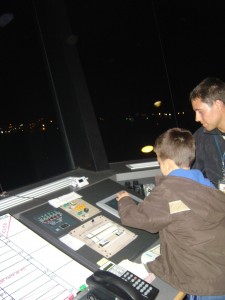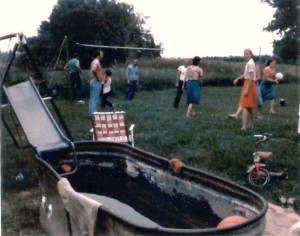Our last flying club meeting featured a tour of the Wittman Regional Airport control tower. How awesome is that?! G tagged along. The airport manager, who is a member of our club, asked us whether we had ever been in the old tower, and I recalled being in that tower when I was G’s age or maybe younger. I. was the controller on duty and he was delighted to have pilots visiting him. We were even more pleased to meet him. G got to turn the runway lights on and off. A pilot may say that isn’t too big a deal, having already done it many times from the airplane, but I think for a 9 1/2 year old, and doing it from the control tower, that’s pretty sweet. Things you probably didn’t know: 1. *Not* including Airventure traffic, Oshkosh is the third busiest airport in Wisconsin, behind Milwaukee and Madison. 2. You can listen to the Oshkosh control tower live on the web
Year: 2009
“When I was your age…”
FamilyThe Smell of Fall
ObservationsHave you ever noticed the scent of fall? Fall has my favourite smells in all of the world. Fall has pumpkin and apple pies, camp fires, and corn. But most of all, fall has the scent of fallen leaves in the woods — best experienced in the evening when the air cools and dew begins to form. Take time to notice the scents of fall today even if, nay especially if, it means you have to go climb a tree and sit there for 2 hours in order to do it.
Flight Test – Private Pilot
AdventuresYesterday, almost one year since my first lesson, I took my flight test. I was pretty relaxed about the thing, but by the end of the lesson, I was sweating and wondering how it was that I passed. The oral test went fairly well, I think, and then it was time to make a go/no-go decision. The winds were fairly high for me (210@13 gusting 19). Well, runway 4-22 had been closed earlier in the week, so I was thinking we should have to use runway 27 and so was the examiner, K. I discontinued the test because I did not want to do a short or soft field landing with that much of a cross wind. But as I was about to leave, I realized that the NOTAMS had not indicated 4-22 was closed, only 18-36. So we continued the test.
We started off on the cross-country towards Dubuque. K pointed out to me that my number 2 navigation radio was not working properly and I should have backed it up by the number 1 and by the GPS. We diverted towards Fond du Lac, and then went on through simulated instrument flight, steep turns, slow flight, and power-on and power-off stalls. K pointed out that I could actually shave 10mph off of my slow flight. After the test, he also pointed out that I tried too hard to induce the stall by increasing the pitch instead of just setting the pitch and waiting for the speed to bleed off. Next came a simulated engine failure, which I handled alright except for I didn’t simulate an emergency radio call and then my chosen field did not have a suitable field adjacent to it. So a field with a backup next door and a backup on the other side would be safer, in case my glide distance was not enough or too much.
Finally, we executed an S-turn across a road, which K said I handled o.k., but only because I staggered through it, not because I anticipated the wind direction and bank angles, which was mostly true. I tried, but just didn’t hit it right. I think that I did fine with my ground reference maneuvers during solo flight and with T because I had more time to think about and plan the maneuver — maybe the pressure was lower — but K took me into it immediately after climbing out from the simulated engine failure and I only had one shot at it. K said I should have that thought out in advance so I don’t have to think about it during the test. In any case, I understood the principle of the thing and explained it when he asked. And I’m not making excuses here, but I think my patterns were a lot better when we went back for touch-and-gos because I did anticipate the crab angles. Now that I think of it though, I could apply that principle better by anticipating a steeper or shallower bank angle in the turns during my traffic patterns, depending on my relationship to the wind.
Short and soft-field takeoffs and landings on runway 22 went o.k., but K kept telling me, “you just completely ignore the crosswind!” and I didn’t understand what he meant because I landed on the center line (at least the second time). Well, after those two landings, we transitioned to runway 27 for a real crosswind landing. The crosswind component was 11, the biggest crosswind I have landed in to date. My sideslip was pretty jerky, but the plane landed close to straight and close to the center line and then K really chewed me out and I realized why he had been saying I was ignoring the crosswind. I had forgotten to deflect the ailerons into the wind after touchdown.
K pointed out afterward that most pilots think the approach is the critical part of the crosswind landing, but really it is the touchdown and rollout. I do a fine job of deflecting the ailerons during taxi, so why should I forget after touchdown? He said something that really made sense to me. Unless there’s a dead calm, If I treat every landing like a crosswind landing, I will develop the habit of deflecting the ailerons every time. In fact, that’s why I am so consistent with it during taxi; I do it no matter how light the wind is. So I am going to go shoot a few on the simulator with that advice and deflect the ailerons on every landing henceforth.
Let’s go flying!
Lessons 39, ground review, and 40
AdventuresMy last two lessons were in preparation for the flight test. T took me through a review of all of the maneuvers that were required for the flight test and made sure that I could perform them proficiently. We did stalls — power on and off — steep turns, S-turns across a road, turns about a point, short-field and soft-field landings and takeoffs, and a little bit of simulated instrument flight. We also spent some time talking about the flight testing procedure and about what I should expect things to be like after getting my private pilot’s license. T encouraged me that he would not have approved me for the test if he didn’t think I were capable and a safe pilot.
Lesson 38 – Unusual Attitudes
AdventuresDuring lesson 38, ZH and K rode along. Again I spent most of this flight under the hood. We flew up to Brennan Field where we executed a low approach and along the way there and back, practised several recoveries from unusual attitudes while under the hood. ZH thought that was great fun, especially the time when we were nose low and fast. K fell asleep within the first fifteen minutes of the flight, which is comforting, funny, and unusual. I recovered fairly well from the unusual attitudes, but like a lot of things, I thought through the process too much and recovered too slow. By the end though, I was just doing it without thinking it through first. I’m also improving at some of the other things like asking for repeated instructions when necessary and adjusting the mixture whenever changing altitude. We executed a soft-field landing at the end of the lesson and it went fairly well. Initially, I didn’t get the throttle down quite low enough so I ate up a lot of runway, but the landing was soft and the nose was high.
Lesson 37 – IFR and Turf
AdventuresDuring Lesson 37, TO rode along. TL asked me to perform a soft field takeoff. I did much better this time, but still have some learning to do. I held her in ground effect longer and better, still not long enough and not well enough though. As soon as we took off and turned east, T had me put the hood on and most of the flight was under simulated IFR conditions. We landed (my first turf landing) and took off at New Holstein and then headed right back to Oshkosh, again under simulated IFR conditions. So I was entirely blind to my first flight across Lake Winnebago and back. T had me perform the approach under simulated IFR up until 1 mile out. That was a satisfying experience.
T says I am already performing IFR flight with some skill and strongly encouraged me to pursue an IFR rating down the road. He also suggested my skills might come from time spent playing video games. Well, I never spent a lot of time on video games, but I have spent a lot of time on flight simulators. I suggested that my skills probably were developed flying a simulator on an Apple IIc in 1987, because the view out the window on that simulator (I think it was Microsoft Flight Simulator 1.0) was of little value. You had no choice but to fly the instruments!
I should like to take this opportunity to thank Mom and Dad for that first flight simulator. I don’t know what they were thinking as they purchased one of our first software packages for that little Apple with the nine inch monochrome monitor, but I was in awe.
Flight 36 – Solo XC No. 3
AdventuresFlight number thirty-six was another solo cross-country. It was not required for the private pilot certificate, but T and I agreed it could only help to have more experience. I found the cross-country navigation to be fairly straightforward, even though there are few landmarks between Oshkosh and Adams County. I flew from Adams County to Wautoma, a very short flight, and thence back to Oshkosh.
I need to work on:
- Remember to adjust the mixture every time I change altitude.
- Remember to start the stopwatch before taking off.
- Adjust for a crosswind that is stronger or weaker than I expected.
- Never give a “roger” when you did not understand the entire call.
It holds that every time I fly solo I encounter something new. This time there was quite a bit of traffic using OSH and a twin Cessna (faster than our 172) was coming straight in for runway 36 so the controller asked me to turn base immediately and then land ahead of him, halfway down the runway. Moreover, the pilot asked to taxi to AeroShell Square. I felt like I was in some small way a part of the AirVenture arrival procedures.
Lesson 35 – Review and IFR
AdventuresDuring flight 35, G got to ride along but his headset wasn’t working properly, so he could not hear us, although we could hear him. We started with a soft field takeoff and proceeded west while T discussed some of what I might expect on the practical test. We reviewed navigation, diversion to an alternate field, and use of the navigation radios. Then I spent some more time under the hood. T says I do really well under the hood but I still need two more hours of IFR instruction. That’s going to take a while to get. We ended with a soft field landing, which I performed satisfactorily, but not excellently.
Flights 32-4 – Short and Soft Field Takeoffs and Landings
AdventuresOn the next three flights, I worked with T on short and soft field takeoffs and landings. Flight 33 was solo. Both techniques were unfamiliar and a challenge at first but with noticeable gains in proficiency by the end if their respective lessons. Again, some more practice is in order because the goal is to do these smoothly, expertly, and safely.
I flew the solo practice on a Friday and Fridays tend to be busy in the air. I was using runway 36 for touch-and-goes and a DC-3 wanted to use runway 18 to takeoff. He waited while I and a few others landed and took off and then he finally got his turn. Well, the unusual thing is that he was taking off in the opposite direction as I was and flying directly across from my left wing down my entire downwind leg. So I had to be aware of wake turbulence from an airplane going the opposite direction as me. …interesting.



